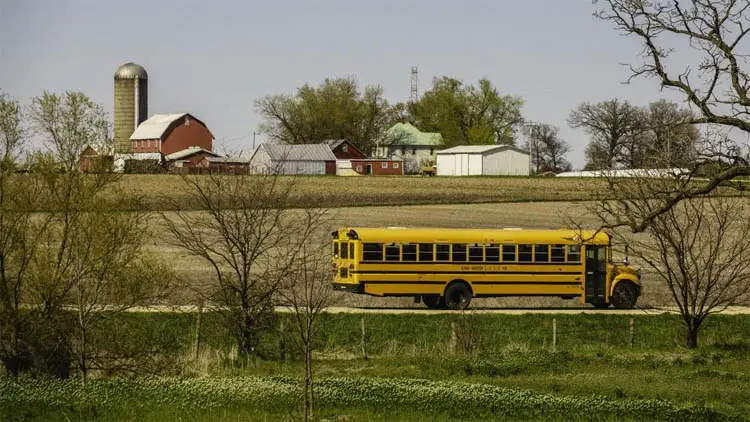Rural America is not your grandparents’ heartland. Its population is getting older: 21 of the 25 oldest counties in the United States are rural. It’s no longer overwhelmingly white: One in five rural residents is a person of color, and more than four of five new rural residents are people of color. Rural areas are also poorer and, ever since the 2007 recession, more affected by unemployment.
As rural America changes, its schools have struggled to keep up. On 2015 NAEP assessments, only one in three eighth-grade rural students were proficient in math or reading, about where urban students scored and well below their suburban peers. While rural students are likely to graduate from high school, they lag far behind on every college indicator—applications, admission, attendance, readiness, grades, persistence, and graduation.
Rural schools are valued and caring community institutions, but they don’t provide everything their students need. Courses in math and science are often less advanced than their titles would imply; barely half of rural districts offer any Advanced Placement courses (compared to 97 percent of urban districts). There’s seldom much help for the growing number of children who speak limited English. Rural schools have high costs—transportation, for example—and often struggle with city-oriented state and federal administrative requirements and limitations on the use of funds.
What can be done to improve rural students’ prospects? Online education, an irresistible possibility for sparsely populated and remote areas, has its limits: to learn well, most students still need contact with prepared teachers, and instruction that helps them build knowledge steadily over time.
Charter schools, if designed around innovative approaches to meet rural students’ needs, are another possibility. Many rural educators and some families fear anything that would draw funds and students away from already too-small and underfunded local schools. But recently, as we illustrate below, chartering has been used to allow communities to innovate in ways that traditional district schools cannot, due to regulatory constraints on hiring, uses of funds, allocation of school time, and class offerings. Some communities that had lost their schools via consolidation have been able to regain them via chartering, and poorly staffed schools have been able to join together to provide better-resourced schools than any one could afford.
One community that has used chartering in these ways is Upper Carmen, Idaho. The ranching community once had its own one-room school, but lost it through consolidation. Taking advantage of Idaho’s charter school law, a new Upper Carmen K–8 school opened in 2005 and now serves about 85 students in multi-age classrooms. A new blended-learning high school that offers students access to advanced courses in math and science is expected to serve about 35 students. According to the school’s founders Jim and Sue Smith, “Education is what will sustain the community. … The community here functions as a society. We do the funerals, the weddings, the births, and why shouldn’t we also educate our children?” The school keeps the community together.
In Colorado, the remote Crestone Charter School was founded in 1996 by a group of parents who didn’t want to see their children bused 12 miles each way to the weakly performing Moffat School District K–12 campus. The Crestone Charter School now serves 93 students in grades K–12 in multi-age classrooms, and it prides itself on helping students become “educated citizens of the world.” High school juniors and seniors take annual learning trips to countries like Japan, India, Chile, and Costa Rica.
In Helena, Arkansas, high school students have new opportunities thanks to a family of charter schools known as KIPP Delta Public Schools. Founded in 2002, KIPP Delta now educates over 1,200 K–12 students across four sites. Local and state leaders worked to recruit KIPP to operate in Helena, and the effort has paid big dividends for the community and its children. According to community leader Chalk Mitchell, “KIPP has helped to eliminate blight. … The first new building constructed downtown in the last 30 or 40 years was the KIPP gymnasium.” KIPP is the largest employer in downtown Helena with more than 150 employees, including 70 teachers. The school draws students from farms and towns as far as an hour’s drive each way.
Charter schools can contribute to rural areas if they meet community needs and capitalize on community strengths, including committed teachers. As CREDO has shown, there are plenty of examples of low-performing charter and cyber schools in rural areas. Just as in urban areas, charter plans should be vetted for quality and a match to local needs. Nobody is likely to benefit if communities are forced to accept cookie-cutter charter schools. All charters, whether rural or urban, should operate under performance-based oversight and continuously prove themselves.
This is what chartering was designed for in the first place—to let educators and communities tailor schools to local (whether town or neighborhood) needs. Over time, political debating points have pigeonholed urban charter schools, especially those run by for-profits and charter management organizations, as an industrialized sector bent on homogenization. But the core of chartering, and its relevance to rural areas, remains: to remove regulatory and legal barriers to innovation while retaining oversight by citizens and elected officials.
Terry Ryan is CEO of the nonprofit organization Bluum, and CEO of the Idaho Charter School Network. Paul Hill is founder of the Center on Reinventing Public Education and research professor at the University of Washington Bothell.
This blog was originally published in the Brookings Institution’s Chalkboard.





